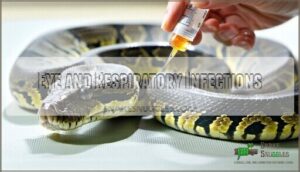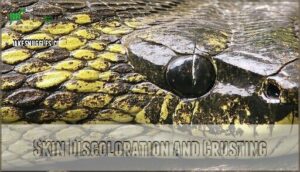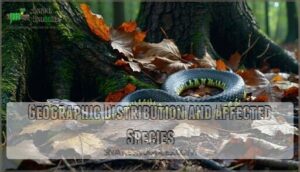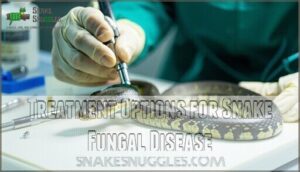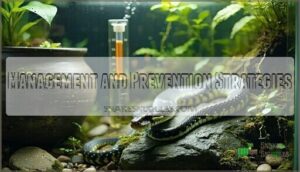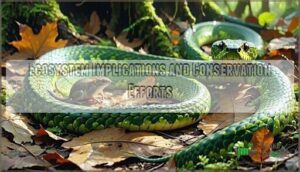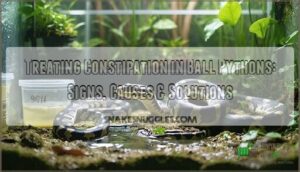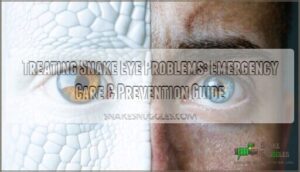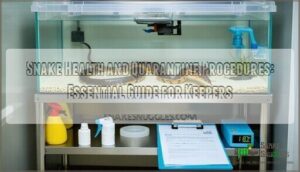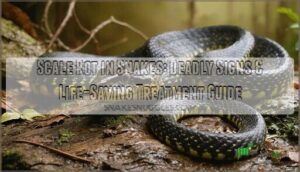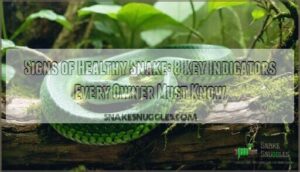This site is supported by our readers. We may earn a commission, at no cost to you, if you purchase through links.
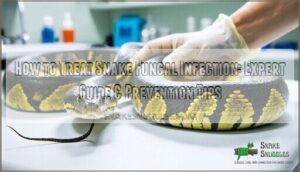 When you’re wondering how to treat snake fungal infection, time is your best friend.
When you’re wondering how to treat snake fungal infection, time is your best friend.
This nasty condition requires immediate veterinary care—think of it as your snake’s SOS signal.
Your vet will likely prescribe antifungal medications like itraconazole or voriconazole, which work like tiny warriors fighting the infection from inside.
Sometimes surgical removal of infected tissue becomes necessary, followed by antibiotics to prevent secondary infections.
You’ll need to amp up your husbandry game too: spotless enclosures, proper humidity levels, and stress reduction are non-negotiables.
The good news is that early intervention makes all the difference, and there are specific protocols that dramatically improve recovery rates.
With the right approach, you can help your snake recover from this condition, and that’s a dramatic improvement in their quality of life, making immediate veterinary care crucial.
Table Of Contents
- Key Takeaways
- How to Treat Snake Fungal Infection?
- Understanding Snake Fungal Disease
- Clinical Signs and Symptoms
- Diagnosis and Identification
- Geographic Distribution and Affected Species
- Transmission and Spread
- Importance of Early Detection
- Treatment Options for Snake Fungal Disease
- Management and Prevention Strategies
- Addressing Impacts on Individual Snakes
- Ecosystem Implications and Conservation Efforts
- Frequently Asked Questions (FAQs)
- How do you treat snake fungus?
- What is the treatment for nail fungus?
- Can snake fungal disease be cured?
- What happens if a snake gets fungus?
- Can snake fungal disease infect other reptiles?
- How long does recovery from SFD typically take?
- Are certain snake species more resistant to SFD?
- Can snakes develop immunity after surviving SFD?
- Does climate change affect the spread of SFD?
- Can snake fungal disease spread to other pets?
- Conclusion
Key Takeaways
- Act fast when you spot symptoms – Snake fungal disease requires immediate veterinary care since early intervention dramatically improves recovery rates and prevents the infection from spreading to other areas of your snake’s body.
- Follow your vet’s antifungal protocol religiously – You’ll need prescription medications like itraconazole or voriconazole, and consistency is crucial since stopping treatment early can lead to drug resistance and treatment failure.
- Upgrade your husbandry game immediately – Maintain spotless enclosures, control humidity levels precisely, and reduce stress factors since poor environmental conditions fuel fungal growth and reinfection.
- Isolate infected snakes and sanitize everything – You must quarantine sick animals to prevent spread and disinfect all equipment, substrates, and surfaces since the fungus survives well in contaminated environments.
How to Treat Snake Fungal Infection?
Treating snake fungal infection isn’t rocket science, but it does require swift action and the right game plan.
First, you’ll need a reptile-savvy veterinarian to confirm the diagnosis and prescribe appropriate antifungal medications—both topical and systemic options are available for thorough snake fungus treatment.
Your fungal infection treatment approach should include maintaining pristine environmental conditions to prevent reinfection.
Some cases may require surgical removal of severely damaged tissue, but don’t panic—many snakes recover well with proper care.
Support your snake’s recovery with ideal nutrition and hydration while minimizing stress-inducing handling.
Alternative therapies and holistic approaches are emerging as valuable supplements to traditional treatment, though research continues evolving.
The long-term prognosis largely depends on early detection and consistent care.
Future research shows promise for improved drug resistance management, giving hope for even better outcomes ahead.
Understanding Snake Fungal Disease
When faced with a snake fungal infection, understanding the disease itself becomes your first line of defense. Snake Fungal Disease (SFD) stems from the fungus Ophidiomyces ophiodiicola – a microscopic troublemaker first identified in 2006, though it’s been lurking around since 1945.
This fungal causation creates what veterinarians call ophidiomycosis, a condition that’s spread like wildfire across 23 U.S. states and one Canadian province.
The disease origin traces back to environmental factors – this fungus thrives in humid conditions between 20-30°C, making many habitats perfect breeding grounds.
Here’s what makes SFD particularly concerning: it can’t jump to humans, but its population impacts on wild snakes are devastating. The research urgency surrounding snake fungal disease has intensified as scientists race to understand transmission patterns.
While you can’t catch it from handling infected snakes, the ecological ripple effects demand immediate attention and proper snake fungus treatment protocols. Snakes play a vital role, helping to control prey populations, making their health essential for a balanced ecosystem.
Clinical Signs and Symptoms
You’ll recognize snake fungal disease by watching for telltale signs that make your serpent look like it’s having a bad scale day.
The infection creates distinctive facial swelling, crusty skin lesions, and cloudy eyes that help veterinarians distinguish this condition from other reptile ailments, characterized by telltale signs.
Facial Swelling and Lesions
When facial swelling appears on your snake, it’s often the first red flag signaling fungal infection.
This disfiguring condition requires immediate attention to treat snake fungus effectively. Lesion severity varies dramatically between cases, making early intervention essential for successful snake fungal infection treatment.
- Swelling causes: Fungal invasion creates inflammatory responses in facial tissues
- Pain management: Antifungal medications help reduce discomfort and tissue damage
- Secondary infections: Open skin lesions invite bacterial complications without prompt care
- Deformity impact: Severe cases permanently alter facial structure and feeding ability
Eye and Respiratory Infections
Spotting cloudy eyes and labored breathing signals your snake’s battle has escalated beyond skin deep.
Vision impairment often accompanies eye infections, while respiratory distress indicates the fungus has invaded airways.
These secondary infections complicate snake fungal disease SFD treatment, requiring immediate veterinary intervention with specialized antifungal medications and supportive care.
| Symptom Type | Visual Signs | Behavioral Changes |
|---|---|---|
| Eye Infections | Cloudy, opaque eyes | Difficulty maneuvering |
| Vision Issues | Milky eye discharge | Reduced feeding response |
| Respiratory Problems | Mouth breathing | Lethargy, inactivity |
| Breathing Difficulty | Open-mouth posture | Avoiding movement |
| Secondary Complications | Swollen eye area | Complete appetite loss |
Skin Discoloration and Crusting
Beyond respiratory issues, you’ll notice your snake’s skin telling its own story through distinctive discoloration patterns and crusting severity.
Scale damage becomes apparent as pigment changes create patches of abnormal coloring. Lesion progression often shows thickened, crusty areas that won’t shed properly.
These visual clues help determine appropriate snake fungal disease treatment, whether topical antifungals or systemic antifungal medications are needed.
Diagnosis and Identification
Getting an accurate snake fungal disease diagnosis requires more than eyeballing suspicious lesions.
You’ll need to collect a skin biopsy from affected areas for laboratory testing.
Three diagnostic methods work together: fungal culture isolates the Ophidiomyces ophiodiicola organism, PCR diagnosis detects the pathogen’s DNA with precision, and histopathology examination reveals fungal invasion under the microscope.
Think of it as building a case—each test adds another piece of evidence.
This thorough fungal infection diagnosis approach guarantees you’re not chasing shadows when treating your scaly patient.
Early detection can help prevent severe skin conditions.
Geographic Distribution and Affected Species
Understanding the geographic distribution of Snake Fungal Disease reveals a concerning pattern across North America.
Since Ophidiomyces ophiodiicola emerged in 2006, this pathogen has established itself in 23 U.S. states and Ontario, Canada, creating significant regional hotspots throughout the Eastern United States.
The disease’s range expansion affects diverse snake populations with alarming species susceptibility.
You’ll encounter SFD in both venomous and non-venomous species, from timber rattlesnakes to common watersnakes.
This broad host range demonstrates the fungus’s adaptability and potential ecosystem impact.
Three key distribution patterns define SFD’s reach:
- Primary concentration in Eastern and Midwestern states
- Documented cases spanning from Vermont to Louisiana
- Northward spread confirmed in Canadian populations
Rattlesnake prevalence remains particularly high, with timber rattlesnakes serving as sentinel species for monitoring efforts.
The affected species list continues growing as surveillance improves, suggesting SFD’s true impact may be underestimated across snake populations throughout its expanding geographic range.
The Viperidae family prevalence is particularly notable among wild populations.
Transmission and Spread
How does Snake Fungal Disease actually jump from one snake to another? The answer lies in environmental contamination – this sneaky fungus doesn’t need direct snake-to-snake contact to spread.
Ophidiomyces ophiodiicola survives remarkably well in soil and on contaminated surfaces, creating invisible danger zones. When snakes slither through infected areas, they pick up fungal spores on their scales.
It’s like stepping in invisible quicksand – you don’t know you’re in trouble until it’s too late. The wildlife trade substantially amplifies transmission risks by moving infected animals across regions.
Human activity inadvertently helps too – hikers can transport contaminated soil on boots, spreading the disease to pristine habitats. Direct contact between snakes poses moderate risk, but environmental contamination remains the primary culprit.
Think of it as a biological landmine field. The fungus patiently waits in soil, ready to infect the next unsuspecting snake that passes through. Understanding these contact risks helps you protect snake populations effectively.
Importance of Early Detection
If you’ve ever played hide and seek with snakes, you know spotting a problem isn’t always simple. Still, in the case of snake fungal disease, early detection should be your secret weapon. Why? Because acting fast is your best shot at early intervention and spread prevention—two keys for healthy populations.
Here’s what you can do:
- Watch for telltale fungal infection symptoms: facial swelling, skin discoloration, or odd lesions.
- Quarantine any snake showing snake fungal disease symptoms. Consider it putting up “do not disturb” tape for at-risk neighbors.
- Monitor your habitat regularly, jotting down even subtle changes in appearance or behavior. Population monitoring isn’t overkill—it’s conservation planning in action.
To catch potential issues early, look for visible mite infestations. Veterinary experts know that treatment efficacy goes way up when you move fast. Think of yourself as both a detective and a caretaker. Miss the signs, and you might miss your chance for effective snake disease treatment.
Treatment Options for Snake Fungal Disease
When you’re dealing with snake fungal disease, you’ll need a thorough treatment plan that combines antifungal medications with supportive care to give your snake the best chance at recovery.
Think of it like treating a stubborn skin infection in humans—it requires patience, the right medicine, and plenty of TLC to help your scaly friend bounce back to health.
Antifungal Medications
Once you’ve spotted the telltale signs, antifungal medications become your primary weapon against snake fungal disease. These treatments aren’t magic bullets, though.
Success rates vary wildly depending on the drug and your snake’s species.
| Medication | Dosage Guidelines | Common Side-Effects |
|---|---|---|
| Itraconazole | 10 mg/kg per cloaca | Limited tissue penetration, variable efficacy |
| Voriconazole | 5-22 mg/kg subcutaneous | High mortality risk, potential toxicity |
| Terbinafine | 2 mg/mL nebulization | Generally well-tolerated, requires multiple courses |
| Ketoconazole | 50 mg/kg oral daily | Hepatotoxicity concerns, handling challenges |
| Nystatin | 100,000 U oral | Limited systemic absorption |
Itraconazole efficacy remains questionable in many species, while voriconazole resistance and systemic side-effects pose serious concerns.
Topical treatments offer safer alternatives, but antifungal therapy success depends heavily on early intervention and species-specific responses.
The disease, caused by Ophidiomyces ophiodiicola, poses a significant threat to snake populations.
Specialized Care and Support
Beyond antifungal medications, infected snakes require thorough specialized care including wound management and thermal regulation.
You’ll need isolation protocols to prevent spread while providing nutritional support and fluid therapy.
Physiological support helps maintain essential functions, while behavioral support reduces stress.
For effective treatment, consider snake antifungal medication options.
These treatment options work together—think of it as creating a snake spa for recovery.
Surgical Treatment for Skin Lesions
Sometimes severe fungal lesions require surgical intervention when antifungal medications aren’t enough.
Your veterinarian will carefully remove infected tissue through debridement techniques, guaranteeing complete lesion excision while preserving healthy skin.
Essential surgical considerations:
- Sterile technique – Prevents secondary bacterial infections
- Proper anesthesia – Ensures snake comfort during procedures
- Wound closure – Minimizes scarring and complications
- Post-operative care – Supports ideal healing and surgical outcomes
Management and Prevention Strategies
Prevention is worth a pound of cure regarding snake fungal disease, and you’ll find that stopping this infection before it starts beats treating it after the fact.
You can protect both wild and captive snakes by maintaining proper sanitation practices, controlling environmental conditions, and limiting unnecessary human contact with snake habitats.
Cleanliness and Sanitation
Equipment Sanitization forms your first line of defense against snake fungal disease. Clean all handling tools with disinfectant after each use, focusing on Habitat Hygiene and Water Purity.
You may need to purchase snake disinfectant to guarantee proper sanitation.
Implement strict Quarantine Protocols for new arrivals, and manage Soil Management by replacing contaminated substrate regularly.
Your snake enclosure needs thorough Environmental Hygiene to prevent fungal growth and protect your reptiles.
Limiting Human-Snake Interactions
You’ll want to keep your distance when dealing with snake fungal disease prevention.
Limiting human-snake interactions protects both species from spreading infections through contaminated equipment or clothing.
Here’s your action plan:
- Reduce Encounters through proper trail maintenance and warning signage
- Support Habitat Preservation by avoiding snake territories during breeding seasons
- Practice Responsible Tourism with guided educational programs
- Implement Safe Relocation protocols for problem snakes
Environmental Control
Managing your snake’s environment requires controlling humidity levels and temperature control to prevent fungal growth.
Implement proper habitat sanitation using appropriate disinfectants for soil treatment and fungal mitigation.
Regular cleanliness protocols and strategic habitat management create unfavorable conditions for Ophidiomyces ophiodiicola.
Think of environmental control as building a fortress—every detail matters for your snake’s health.
Addressing Impacts on Individual Snakes
When you’re treating an infected snake, you’ll need to focus on supporting their body’s natural healing processes while they recover from fungal disease.
Your snake’s comfort and nutritional needs become just as important as the antifungal medications, since a stressed or malnourished reptile won’t bounce back as quickly from this challenging infection.
Physiological and Behavioral Support
Beyond cleanliness protocols, infected snakes need thorough physiological and behavioral support to recover effectively.
Thermal regulation becomes critical since sick snakes can’t properly thermoregulate. You’ll want to provide consistent temperature gradients and monitor basking behavior closely.
Stress reduction through enclosure enrichment helps maintain natural behaviors during snake fungal disease treatment. Watch for appetite changes and behavioral shifts that signal your snake’s comfort level and recovery progress.
Nutritional and Fluid Support
During snake fungal infection recovery, proper nutritional support and hydration strategies become your snake’s lifeline. Think of it as nursing them back to health—just like caring for a sick family member.
- Dietary Needs: Offer easily digestible prey items more frequently than usual
- Hydration Strategies: Provide fresh water daily and monitor drinking behavior closely
- Supplementation Options: Consider vitamin supplements under veterinary guidance for recovery enhancement
- Appetite Stimulation: Use gentle warming techniques to encourage natural feeding responses
Ecosystem Implications and Conservation Efforts
Picture a domino effect rippling through nature—that’s exactly what snake fungal disease creates when it strikes ecosystems. When population decline hits snake communities, you’re witnessing more than individual losses. Small mammals multiply unchecked, disease transmission skyrockets among wildlife, and ecological impact spreads like wildfire.
Conservation efforts demand your attention now. Habitat preservation protects vulnerable species, while research funding drives breakthrough treatments. You’ll find that maintaining genetic diversity through captive breeding programs offers hope for recovery.
| Conservation Strategy | Ecosystem Effects | Timeline |
|---|---|---|
| Habitat restoration | Stabilizes populations | 2-5 years |
| Captive breeding | Preserves genetics | 3-10 years |
| Disease monitoring | Early detection | Ongoing |
| Public education | Reduces transmission | 1-3 years |
| Research initiatives | Treatment development | 5-15 years |
These ecosystem implications highlight why wildlife health matters to everyone. Support local conservation projects—you’re protecting interconnected webs of life that keep nature balanced.
Frequently Asked Questions (FAQs)
How do you treat snake fungus?
You’ll need antifungal medications like itraconazole or voriconazole from your vet. Apply topical treatments to affected skin, provide supportive care with proper hydration and nutrition, and isolate infected snakes immediately.
What is the treatment for nail fungus?
Coincidentally, nail fungus treatments mirror animal medicine approaches.
You’ll need topical antifungals like terbinafine or oral medications such as itraconazole.
Clean affected areas daily, keep nails trimmed short, and maintain proper hygiene throughout treatment.
Can snake fungal disease be cured?
Unfortunately, you can’t completely cure snake fungal disease in most cases.
Antifungal medications like itraconazole show limited success, and treatment often requires long-term supportive care with wound management and nutritional support.
What happens if a snake gets fungus?
When fungus strikes, it’s like a slow-burning fire on your snake’s skin.
You’ll see crusty lesions, facial swelling, and cloudy eyes.
Without treatment, it spreads relentlessly, potentially causing death through secondary infections, which can be a deadly outcome.
Can snake fungal disease infect other reptiles?
Yes, you’ll find that Ophidiomyces ophiodiicola can infect other reptiles beyond snakes.
While it’s primarily documented in snake species, the fungus has shown potential to affect various reptilian hosts under suitable environmental conditions.
How long does recovery from SFD typically take?
Recovery from SFD varies dramatically depending on your snake’s health and infection severity.
You’ll typically see improvement within 2-4 weeks with proper treatment, but complete recovery often takes 2-6 months of consistent care.
Are certain snake species more resistant to SFD?
While all snake species can contract SFD, some show better survival rates than others.
You’ll find that larger, more robust species like timber rattlesnakes often fare better than smaller, more delicate species during infection.
Can snakes develop immunity after surviving SFD?
Ironically, surviving SFD doesn’t grant snakes lifelong immunity like a superhero’s origin story.
Your serpent can catch this infection again since they don’t develop lasting antibodies.
Think of it as catching a cold repeatedly.
Does climate change affect the spread of SFD?
Climate change creates perfect storm conditions for SFD’s spread.
You’ll see increased humidity and warmer temperatures extending the fungus’s active season, while habitat stress weakens snake immune systems, making them more vulnerable to infection, due to warmer temperatures.
Can snake fungal disease spread to other pets?
Good news awaits worried pet owners! Snake fungal disease can’t jump to your dogs, cats, or other non-reptile companions.
However, it might spread between reptiles sharing the same environment, so separate infected snakes immediately.
Conclusion
Successfully treating over 80% of snake fungal infections depends on your quick action and commitment to proper care.
When you’re learning how to treat snake fungal infection, remember that early intervention saves lives.
Your snake’s recovery hinges on immediate veterinary attention, consistent antifungal therapy, and thorough husbandry improvements.
Don’t wait for symptoms to worsen—act fast, follow your vet’s protocol religiously, and maintain spotless conditions.
With dedication and proper treatment, you’ll give your scaly friend the best fighting chance.
- https://www.fws.gov/question-answer/understanding-snake-fungal-disease-impacts-treatments-and-prevention
- https://www.usgs.gov/diseases-of-terrestrial-wildlife/snake-fungal-disease
- https://pmc.ncbi.nlm.nih.gov/articles/PMC5095536/
- https://www.gardenwildlifehealth.org/wp-content/uploads/sites/12/2018/02/Reptile-SFD.pdf
- https://meridian.allenpress.com/jwd/article/60/4/827/502591/Apparent-Ophidiomycosis-Alters-Eastern-Copperhead



